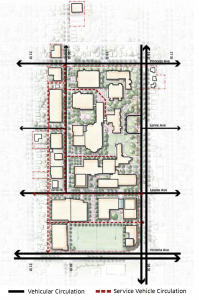Vehicular Circulation & Street Network
BU benefits from being well integrated into its urban fabric by means of a grid network of north-south and east-west streets. This allows the Campus to be well accessed by all modes of transportation from every direction. Once one reaches the periphery of the campus, however, vehicular circulation is primarily for the purpose of accessing parking, servicing corridors, or to connect to the neighbourhoods. Vehicular circulation through the Campus and the function of the streets gives priority to pedestrian and cycling movement. The Campus Master Plan recommends a strategy for surface parking either on street, below grade in new buildings, or in parking structures. Other than service vehicles, vehicular circulation functions primarily to get cars into parking facilities at the perimeter of the campus.
Street Network
The Movement Framework is defined by a system of external city streets, internal campus streets, laneways, and service routes. The Campus Master Plan increases road connections to the surrounding neighbourhood to make the Campus more accessible, and walkable. The Plan includes recommendations for the external city streets because they affect the way in which students and the community access the University. The character of these streets also play a role in defining the character and identity of the Campus along its edges. The following section defines the hierarchy of streets within the Framework and provides a structure for how the different modes of movement work together to create a walkable, safe, pedestrian-oriented environment. Each street is described below and cross-section details are provided, including for 18th Street.
Boundary Streets
These main streets comprise the main boundaries of the campus, including 18th Street, Victoria Avenue and Princess Avenue.
Internal Streets
These streets are internal to the campus, although still part of the city’s street network, including Louise Avenue and 20th Street.
Residential Streets & Service Routes
These smaller roads and access routes are nevertheless important for access to all points on campus.
Laneways
Shared laneways are vehicular and service access routes to existing and new buildings fronting 20th Street. They are also pedestrian circulation routes that connect to pathways and linkages into the Campus.

